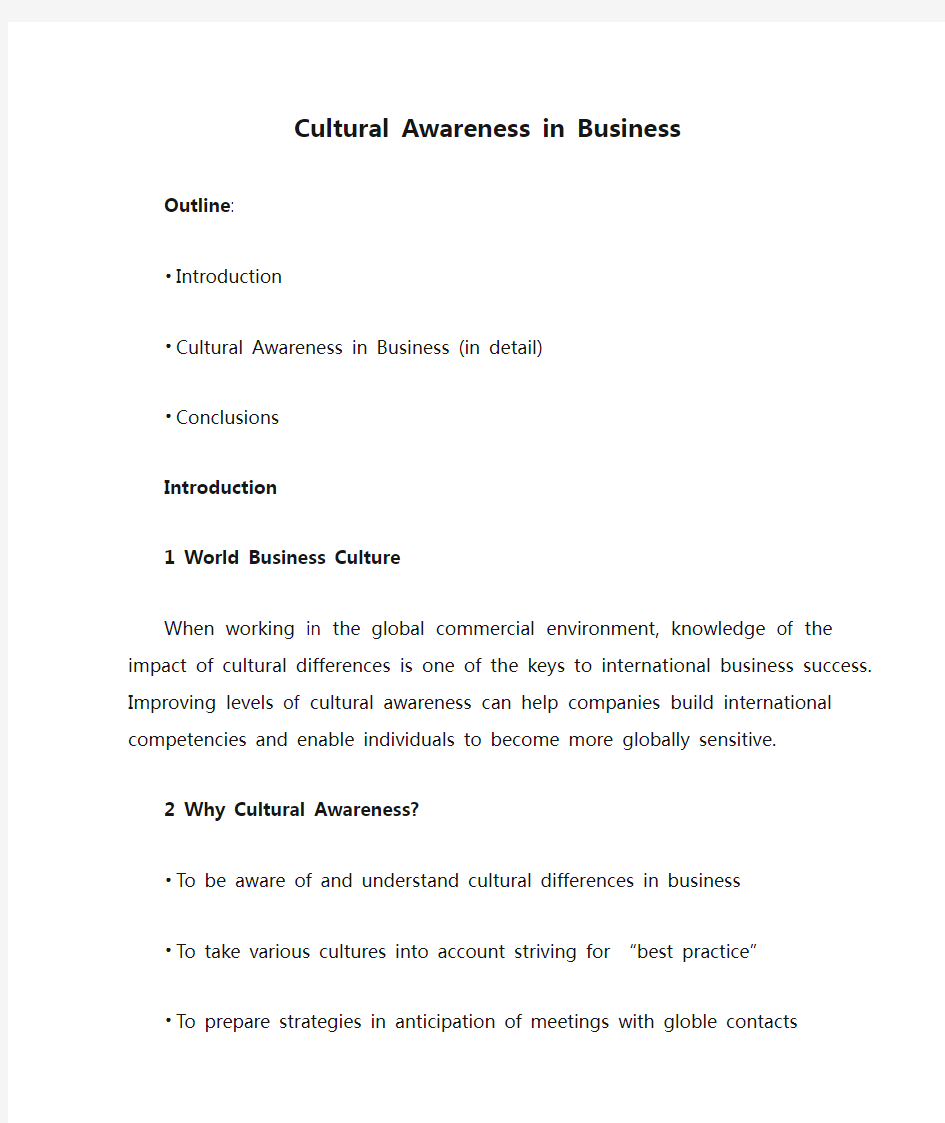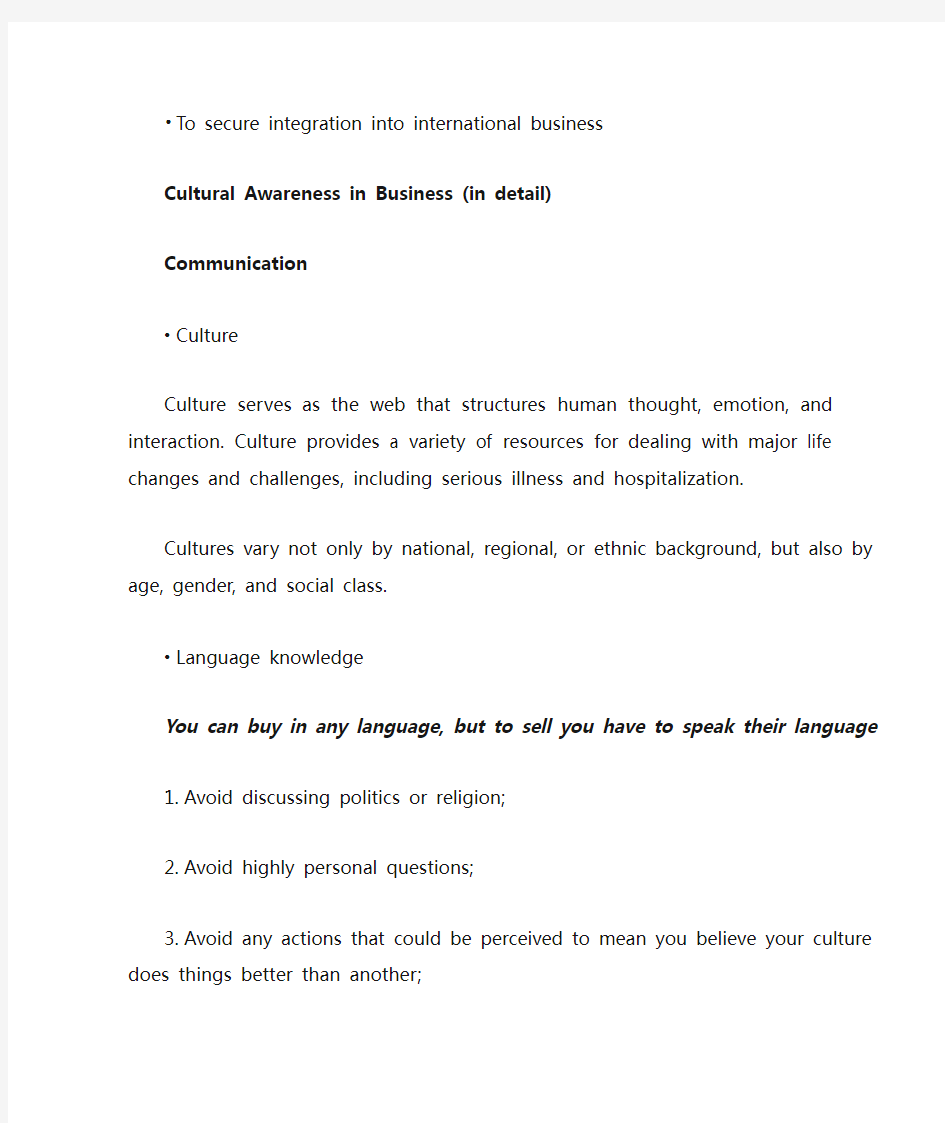Cultural Awareness in Business


Cultural Awareness in Business
Outline:
?Introduction
?Cultural Awareness in Business (in detail)
?Conclusions
Introduction
1 World Business Culture
When working in the global commercial environment, knowledge of the impact of cultural differences is one of the keys to international business success. Improving levels of cultural awareness can help companies build international competencies and enable individuals to become more globally sensitive.
2 Why Cultural Awareness?
?To be aware of and understand cultural differences in business
?To take various cultures into account striving for “best practice”
?To prepare strategies in anticipation of meetings with globle contacts
?To secure integration into international business
Cultural Awareness in Business (in detail)
Communication
?Culture
Culture serves as the web that structures human thought, emotion, and interaction. Culture provides a variety of resources for dealing with
major life changes and challenges, including serious illness and
hospitalization.
Cultures vary not only by national, regional, or ethnic background, but also by age, gender, and social class.
?Language knowledge
You can buy in any language, but to sell you have to speak their language
1.Avoid discussing politics or religion;
2.Avoid highly personal questions;
3.Avoid any actions that could be perceived to mean you believe
your culture does things better than another;
4.Keep you communicating simple and straightforward.
5.Introduce frequent feedback to determine whether the listener
has understood.
?Language tone
?Handshake
?Communication style
Cultural influences
Different culture obey different daily life rules :
?Day starts
Aware the time are different in your partner’s country.
?Dress style
?Appearance value
You should make yourself looks properly in your apperance facing to different people.
?Punctuality
?Lunch/Dinner
?Gift habits
Company structure
?Organization
?Orientation
?Networking importance
?Flexibility
Work interaction
?Speed of trust
?Program analysis
?Decision making
?Time to decide
?Importance of rules
?Style
?Uncertainty level
Conclusions
?Consider Cultural Awareness is:
1. A unenviable trend
2.An essential element of doing business abroad
3. A less risky alternative to product innovation
4. A way enter the international market
culturalrelics教学设计教案
Unit Unit 1 Cultural Relics Heading Topic and Content Teaching Goals and Objectives Grade Level: Senior Grade One Time: 45min Description of students: For the students in grade1 in senior high school, their basic knowledge of cultural relics is enough. So the topic of this unit is familiar and easy to them. However, the passage in this unit is about another unfamiliar cultural relic---the Amber Room, so it is a little difficult to them. In addition, this passage is logically organized through three clues. So to the students, this passage is hard to grasp. Topic: Cultural Relics Teaching Content: 1.Key vocabulary: amazing, honey, decorate, select, belong, remove 2.Subject matter: 1.) recall the famous cultural relics around the world 2.) emphasis the importance of protecting of cultural relics 3.) reading comprehension---In Search of The Amber Room 1.Teaching Goals: 1.)Talk about history and background of the cultural relics 2.)Improve the students’ reading ability through the passage 2.Teaching Objectives: 1). Ability objectives Towards the end of this unit, the students should be able to: A. Enable the students to have the ability of talking cultural relics and ways to protect them. B. Learn some detailed information about the Amber Room. C. Train the students ability’ to grasp key information and clues while listening. D. Learn to skim for the main idea of this passage E. Fully understand the passage through the clues. F. Retell the passage in their own words. Teaching Key Points and Difficult Points 2). Emotion objective Make the students realize the importance of protecting the cultural relics and take action to protect them. 1.Key Points: 1).The key words and expressions; 2). Learn some detailed information about the Amber Room; 3). Train the students’abilityspeaking. 4). Improve the students ’ reading ability, including skimming and scanning. 2.Difficult Points: Train the students’ ability to grasp key information while listening. Lesson Step1Lead-in (4 minutes)
高中英语必修二知识讲解 Unit 1 Culturalrelics语言点
Unit 1 Culture relics 单元语言点 目标认知 重点词汇 rare, valuable, survive, doubt, remove, amazing, select, design, remain, worth, fancy 重点短语 belong to, in return, serve as, think highly of, part of, in search of 重点句型 1. could have done 2. Nor do I think... 知识讲解 重点词汇 rare 【原句回放】Does a cultural relic always have to be rare and valuable? 文化遗产总是稀少而贵重的吗? 【点拨】rare adj. 稀少的, 罕见的;稀薄的 It is rare to see a man over 160 years old. 很少见到一个人能活到160岁。 The air is rare at high altitudes. 高处空气稀薄。 【拓展】occasional, uncommon, scare, rare均含“稀罕的、很少发生”之意。 occasional 指偶然、间或发生的事,侧重无规律可循。 uncommon指一般不发生或很少发生的事情,故显得独特、异常与例外。 scare指暂时不易发现、不存在或数量不足,供不应求的东西。 rare指难得发生的事或难遇见的人或事,侧重特殊性。 valuable 【原句回放】Does a cultural relic always have to be rare and valuable? 文化遗产总是稀少而贵重的吗? 【点拨】valuable adj. 很有用的,宝贵的;很值钱的,贵重的(=of great value) valuable experience 宝贵的经验 valuable jewelry 贵重的首饰 This is one of the most valuable lessons I learned. 这是我所学到的最宝贵的教训。 Is the watch valuable? 这块表很值钱吗? 【拓展】valueless 无价值的,不值钱的(=of no value) worthless 没有用的,无价值的; priceless 无价的,极重要的,珍贵的 【高清课堂B2U1重点词句】 survive
高中英语新人教版必修二《Unit1Culturalrelics》全单元教案
The First Period (Warming up, one class) (By PowerPoint) Teaching Aims: 1. To learn the knowledge of the cultural relics. 2. Discuss how to protect our cultural relics. Teaching Design Step One: Presentation (By showing them some photos of some famous cultural relics.) Hello, everybody, let’s look at the screen. I’ll present your some pictures. They are all very famous places in China or in the world. Please think these over: A.Can you name them out? B.Who have the right to own and confirm them? (The shown pictures:①The Great Wall, ②The Imperial Palace of the Ming and Qing Dynasties in Beijing and Shenyang; ③The Mausoleum of the First Qin Empeor and the Terracotta Warriors) Let the students name out the famous places in the pictures, and tell them they are cultural relic s. And explain what cultural relics are. A. a cultural relic is sth that survive d for a long time B. a cultural relic may be a part of old thing has remain ed when the rest of it had been destroyed C.or a cultural relic is something rather rare (while showing these photos, teach the new words in red: cultural relics, survive, remain, rare) 1. Get the students understand the identity of the cultural relics. 2. Let the students try to know that they are at least two sites of cultural relics, the natural site; and the cultural site. ( By showing the pictures of some natural sites relics. Eg: Mount Huashan, The JiuZhaiGou Valley, River Li ) Step Two: Drills Let the students make some more examples of cultural relics, including the ones inside our country or in other countries, especially the ones in our location. Here are some possible answers from the students: (The Neiguan Cave(内莞岩); The Xinfengjiang River(新丰江); Heyuan Dinosaur Park(河源恐龙公园); Yuanmingyuan(圆明园), etc.) (The Sydney Opera; The white House; The Big Ben; The Amber Room, etc.) Step Three: Discussing 1 As we all know that cultural relics are rather valuable, rare, and sometimes, it is in very high price. 1.Then can you tell the value of the cultural relic?(Have the students discussed for some time in teams, then get their answers by expressing in class.) (There will be a lot of possible answers. Eg: From the cultural relics we can know what people did
人教版高中英语必修二Unit1Culturalrelics
高中英语学习材料 madeofjingetieji Unit 1 Cultural relics 同步检测 第一部分基础测试 A. 单词拼写 请根据汉语提示或首字母写出单词的正确形式 1. The ________ (花瓶) belong to the Ming Dynasty. 2. The Great Wall is one of the ___________ (奇迹) of the world. 3. We are going to buy some __________ (家具) for our new house. 4. You shouldn’t _________ (假装) to know what you don’t’ know. 5. I don’t like the colour of the car. ___________ (而且), it’s too expensive. 6. Train fares are likely to r________ unchanged. We can still buy cheap tickets. 7. These houses are made of bricks and s_________. 8. When h_________, the amber can be made into any shape. 9. The family j_______ are locked in a safe. 10.We should do everything we can to protect c__________ relics instead of destroying them. B. 句型转换 根据A句句义,用本单元所学的句型或短语完成B 句,使其句义相同或相近。 11. A: Once heated, the amber can be made into any shape. B: Once ______ ______ heated, the amber can be made into any shape. 12. A: It took a team of the country’s artists ten years to make it. B: A team of the country’s artists _______ ten years _____ _____ it. 13. A: I don’t know what he’s doing. I don’t care, either. B: I don’t know what he’s doing. _____ _____ I care. 14. A: She went into the kitchen to look for a drink. B: She went into the kitchen in ________ ________ a drink. 15. A: This dictionary is very useful in our English study.
必修2unit1culturalrelics教学设计方案
人教版新课标高一必修2 Unit 1 Cultural Relics--教学设计 教师行为学生学习活动设计意图(一)创设问题情境,激趣导入 1.教师用 PowerPoint 分 别展示三幅图片以及有 关的介绍,并不需要学 生详细记录细节,只是 了解图片是什么地方, 位于哪个国家等。 2.展示各种各样令人惊叹 的琥珀, 3.给学生以感官上的刺 激,引起学生极大的兴 趣,然后提问,What is amber?Have you ever seen a piece of amber?再给学生将讲 讲琥珀是怎样形成的, 之后再问Can you imagine a house made of amber?从而引出 reading部分。学生观察图片,说出自己的 想法。 利用多媒体课件创设情境激 发学生学习兴趣,给学生心 理上的支持,创设良好的学 习氛围。 (二)热身
教师设定几个问题Good morning,class.This period w ar going to rad about IN SEARCH OF THE AMBER ROOM Before our reading,I’d like to know: 1.What kind of old things ar cultural relics? 2.Are all the old things cultural relics? 提高学生应答意识熟练掌握与此部分话题相关 的重点词汇、短语及句子 (三)课前预习 1.让学生解释文章的 title—In Search of the Amber Room(Maybe it ' s lost) 2.为了让学生知道琥珀屋 是什么样子,帮助理解 文章,教师展示多张图 片,琥珀屋的外观、以 及里面摆设,光彩夺目, 金碧辉煌的琥珀屋使学 生大开眼界,叹为观止。 1.说出本单元单词,尤其 是修饰性的单词。 2.用连词成句的形式,小 组讨论增加学习兴趣。 1.充分利用多媒体技术。 2.培养学生组织语言、运 用语言的能力。 (四)阅读 为全体学生进行有效阅读策 略的点拨与指导,如略读、 寻读、预测和分析性阅读。 1.Skimming for the general idea of each paragraph 2.Ask students to read 1.按4 人一个小组,把学 生分成A、B、C、D... 若干个小组进行相关问 题的讨论。讨论后每组 推出一个同学回答,答 对给1 分,答错扣1 分, 在黑板左上角公布各小 培养学生的质疑意识,提高 学生分析问题和解决问题的 能力。
人教版必修2 Unit 1 Cultural relics 1
Asweallknow,therearealargenumberofculturalrelicsallovertheworld.Nowadays,moreandmorepeopleareinterestedinthetopicabouthowtoprotectculturalrelics.Culturalrelicsalsoh avebeguntobeahottopicinChinatodayasthebalancebetweendevelopingthenationandkeepingtraditiona lculture.Thiscanbeseeninthepublic’shopetorebuildplacesofinterest.ThiscanbeseeninBeijingast raditionalcourtyardsareremovedtomakewayforlarge,modernbuildings.AspeoplegainmoremoneyandareabletomovearoundfreelyinChina,theywanttoprotecttherelicsoftheirculturalpast.Peoplenowwishtoprotecttraditionalarchitecture (建筑物) likeoldcitywallsinsteadofknockingthemdown.Someevenwishtorebuildthosethathavebeentorndown.Th eChinesepeopleshowtheirinterestinthefolkartsandhopethatsomenewcultureexhibitionswillbehelpf ultoeducatepeopletoprotectsomeculturalrelics.Inaddition,Chinesecultureisalsospreading(传播) inmanyforeigncountries.ChinesestudiesabroadhaveincreasedagreatdealasChinabecomesmoreofagrow
Unit 1 Cultural Relics -课后反思
Unit1CulturalRelics?课后反思 Unit1CulturalRelics?课后反思 Unit1CulturalRelics课后反思 一、教材及学情分析 (一)教材内容分析 本单元话题——文化遗产(Culturalrelics)历来是全世界较为关注的焦点之一,尤其是在近些年,大量代表古人类文明的文物、古迹惨遭破坏,甚至毁灭!本单元所采用话题构成了一个现代意义十足的时尚理念,能够充分唤起学生的参与欲望。单元内容极具生活化,富有活力,体现了本套的一个重要特征,即紧扣时代脉搏,富有时代气息。而本节课是本单元的第一课时,主要是让学生学习本单元的重点单词,通过各种语境学习词汇,滚动式呈现词汇,操练、检测和运用词汇。从开始的通过语境猜测词汇含义,到使用词汇描述文物古迹,再到通过讨论呼吁进行文化遗产保护,最后根据讨论内容落实到书面写作。整节课自始至终围绕保护代表人类历史与文明的文物古迹这一主题,所有的人物设计都围绕着本节课的重点——对词汇的学习及运用。通过本节课学习,不但向学生传授了英语知识,而且还在教学过程中通过渗透的方式将文物保护知识有机地渗透于课堂教学之中,培养学生爱护人类文明、保护文物古迹、热爱伟大祖国的思想品德。 (二)教学重点、难点 本节课是一节词汇学习课,所以重点就放在对重点词汇的学习,强调让学生通过不同的语境猜测词义,再通过选词填空,词义连线训练与巩固,并通过讨论任务使学生真正掌握重点词汇的使用。而本节课最后一个任务,让学生通过本节课的学习用所学的重点词汇进行写作练习,这是对学生综合运用能力的一个考验,也是本节课的难点。
(三)学情分析 这次的授课对象为高一新生,他们刚开始接触高中,较之以前初中简单的英语课本,现在看到每个单元大量的词汇学生都会产生畏惧感。而他们中有不少学生背单词还是靠死记硬背,效果也不好,往往是记住了也不会用。面对如此状况,学生也会渐渐失去学习的兴趣,影响到学生往后的英语学习所以,采用语境中教学词汇,可以帮助学生顺利完成初高中英语学习的过渡,在一定程度上消除了学生记忆大量词汇的畏难情绪,并对学生自主积累词汇有一定的帮助。 二、教学目标 (一)语言知识目标 1.使学生能够学习在不同的语境中猜测重点词汇的词义, 2.并会使用重点单词来描述历史文化遗产的特征。 (二)语言技能目标 1.培养学生在不同语境中的猜词能力, 2.以及使用合适的语言来表达自己观点的能力。 (三)情感目标 1.使学生能够热爱并保护历史文化遗产, 2.培养小组合作学习的能力。 (四)教学策略 1)在情境中教学词汇。滚动式呈现词汇,操练、检测和运用词汇。 2)引趣激趣策略。创设多种情景(境)激发学生的兴趣,只有让学生真正有了参与的欲望,才能点燃他们的思维火花。 3)任务型活动策略。在做中学,在做中练,在做中巩固,往往会使课堂教学产生事半功倍的良好效果。 4)循序渐进和尊重差异策略。由简到繁,由难及易,为有困难的学生搭好梯
人教版高中英语必修二Unit1Culturalrelics试题及答案
修改:在错的词下划一横线,并在该词下面写上修改后的词。 注意:1. 每处错误及其修改均仅限一词。 2.只允许修改10处,多者(从11处起)不记分。 Long long ago, people had gather leaves and fruit of plants to eat with. They didn’t know how to plant crops or how to keeping animals for their food. We call them Stone Age people.Thing for them were terrible and hard. Now there have still some people living liked those Stone Age people.They live in places that are hard reach. They do not know of our invention, for they keep themselves away our civilized world. For many years a group of people call Aruntas have lived alone in the center 第二节书面表达 安徽黄山被联合国教科文组织定为世界自然文化遗产。假设外国友人到你校参观后,准备去旅游。请根据要点向外国友人简单介绍黄山(the Yellow Mountain)。 ①位于安徽南部,是中国著名的旅游胜地。每年有大批中外游客前去旅游观光。 ②乘汽车去大约要花3个小时;也可以乘火车或飞机去。 ③登山便可领略其云海(the sea of clouds)、奇松(wondrous pines)、怪石(unique rocks) 等秀丽的风景及清晨美丽的日出。
CulturalRelics教学反思
Cultural Relics教学反思 教学年级:高一 课题名称:Cultural Relics阅读课 教材版本:人教版高中英语必修2 授课时间:45 分钟 一、学生分析 教学对象为高中一年级学生,智力发展趋于成熟。他们的认知能力比初中阶段有了进一步的发展,渐渐形成用英语获取信息、处理信息、分析问题和解决问题的能力,因此我特别注重提高学生用英语进行思维和表达的能力。他们学习英语方法由死记硬背转型向理解型并应用到交际上,他们有自己的学习技能和策略,学会把语言学习与现实生活和兴趣联系起来。通过任务型课堂活动和学习,学生的学习自主性得到加强,不再认为英语的课堂学习很枯燥,主动参与到活动中去,成为课堂的主体,同时也加强了与他人交流合作的能力。学生已经完成了高中英语第一个模块的学习,渐渐习惯了我的教法。虽然一开始他们觉得与初中教学很不相同(初中老师注重手把手式的语法教学),但经过半个学期后,他们适应得很快,而且还取得一定的进步。他们会对课文内容提出自己的疑惑和勇于阐述见解,并且从课内知识拓展到课外,通过多种渠道获取学习资源。不过,本班学生的水平参差不齐,有些差距还相当大。因此在教学过程中,布置的任务要兼顾各个层次的学生,使他们都有所收获。 二、教材分析 这一课是本单元第一个课时。在上这一节课前并没有让他们了解太多的与课文内容相关的知识,只是由于这课出现的人名和地方名比较多,我在课前教他们读了一下。我在备这一课时,发现它的warming-up 部分会花费比较长的时间,于是我没有采用,而使用了我自己另外准备的引入(只是花了 4 到5 分钟的时间),让学生对这课的话题作好心理准备,也为了完成本单元的目标作了铺垫。我觉得在今后也必须合理使用手中的教材,根据学生水平和教学设计进行整合或增减,让不同层次的学生在课堂上都有所收获。 三、教学目标 本课为阅读课型,主要介绍有关俄罗斯遗失琥珀屋的轶事。通过阅读使学生了解世界文化遗产,学会描述他们的起源、发展和保护等方面的情况。教师根据课文内容用不同的形式来让学生自己归纳,提高阅读技能。由于这课讲述国外文化遗产,学生会感到陌生,为了引起共鸣,因此要把中外文化遗产结合一起讨论。本课目的要使学生学会如何谈论文化遗产以及最后形成保护文物的意识。 教学内容大致分为以下几个方面: 1 、看图片和听录音引入文化遗产这一话题。 2 、从网上下载一些琥珀屋图片并展示给学生看,分辨新旧琥珀屋,给学生以感官上的刺激,而且有利于帮助学生对文章的理解。(一些生词用板书) 3 、学生阅读课文后完成精读练习。 4 、两人围绕琥珀屋设计小对话。 5 、语言学习-- 难句解释。 6 、小结文章,一是找关键线索,二是写作手法。 7 、小组讨论,包括复述课文,加深对文章的理解,以及学生总结自己通过本课学习学到了什么(达到教学目标-- 形成保护文物意识)。
高中英语人教版必修2Unit1CulturalrelicsReading教案(系列一)
必修二Unit1 Cultural relics Period1 Warming up and Reading Aims: 1.To read about cultural relics. 2. To learn about The Restrictive and Non-Restrictive Attributive Clause. Warming up: Warming up by defining Good morning, class. This period we are going to read about IN SEARCH OF THE AMBER ROOM. Before our reading, I’d like to know: A.What kind of old things are cultural relics? B.Are all the old things cultural relics? C.What is the definition and classification of cultural relics? D.To whom do cultural relics belong? Warming up by presenting Hi, everyone. Let’s look at the screen. I’ll present you some pictures. They all belong to cultural relics. Some of them are cultural sites. Some of them are natural sites. Please think these over: A.Can you name them out?
